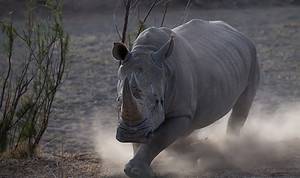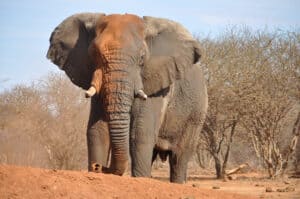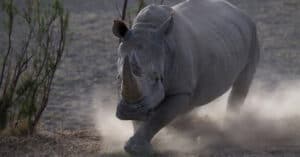There are two species of African rhinoceroses: white rhinos and black rhinos. There are also 3 Asian rhino species: great one-horned rhinos, Javan rhinoceroses, and Sumatran rhinos. Black rhinos have been the most imperiled, which begs the question; are black rhinos extinct?
Rhinos are not endemic to Africa, and before they were poached to the brink of extinction, they roamed Europe, Asia, and Africa. There are rock paintings from Niger that show rhinoceroses from 2000 BC. In the 20th century, 500,000 rhinos existed.
By the 1970s, that number had dropped to around 70 thousand individuals.
They’re still under direct threat from poaching and habitat destruction, and almost all of the extant rhinos today live in reserves and national parks. Those that are not within the boundaries of a protected area usually don’t survive.
Today, there are less than 30,000 wild rhinos, and a few subspecies have gone extinct. What about black rhinos? Are any black rhinoceroses extinct?
Is the Black Rhino Extinct?
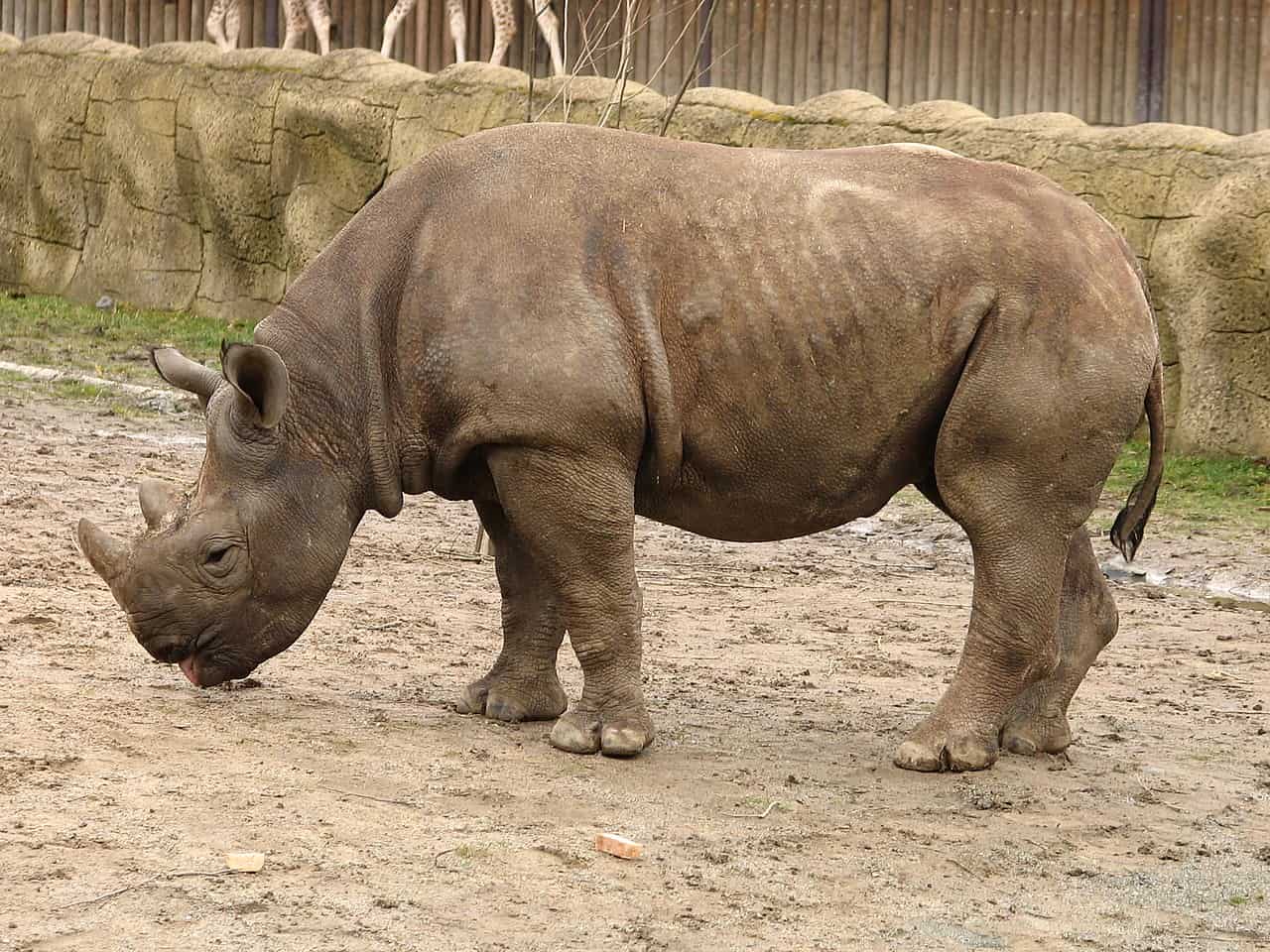
Four out of seven types of black rhinos are extinct in the wild.
©Mistvan, CC BY-SA 4.0, via Wikimedia Commons – License
Yes, 4 out of 7 types of black rhinos are extinct in the wild. The most recent extinction is that of the western black rhino, although the southern black rhino, the northeastern black rhinoceros, and most likely the Chobe black rhinoceros are extinct.
Black rhinos as a species are listed as critically endangered. Extant black rhino subspecies are the eastern black rhino, the south-central rhino, and the southwestern rhinoceros.
In 2011, the western black rhino was declared extinct by the IUCN (International Union for Conservation of Nature). It was recommended in 2006 that the western black rhino be declared extinct, but the IUCN puts a 5-year waiting period on extinction designations to make sure they’re gone, and no new individuals will be spotted.
The last sighting of the western black rhino was in 2003 within their only habitat left in Cameroon. Poachers did away with the individuals left after their home range was further strangled.
Why Are Rhinos Still Going Extinct?
Rhinoceroses are still going extinct because of habitat loss and poaching. Wars taking place in their range also exacerbate the problem. Black rhinos, in particular, were decimated in the 20th century for sport, and there was no bounce back before mass alterations to their ecosystems became commonplace.
There is a special interest in rhinoceros horns in Asian countries where it is used for various purposes, such as a cure for cancer. The use of rhino horns for ornate purposes goes back to 1200 BC, as documented by the Chinese.
A dagger made of rhino horn from the Middle East called a jambiya had been made for centuries. Modern demand in the region for jambiyas in the 1970s reduced the black rhinoceros population by 98%.
Black rhinos as a species also deal with competition. Animals like the African bush elephant are also grazers like the black rhino. Vegetation is becoming limited, and while the threat isn’t huge yet, it could become more of a problem.
What’s the Difference Between a Black and a White Rhinoceros?
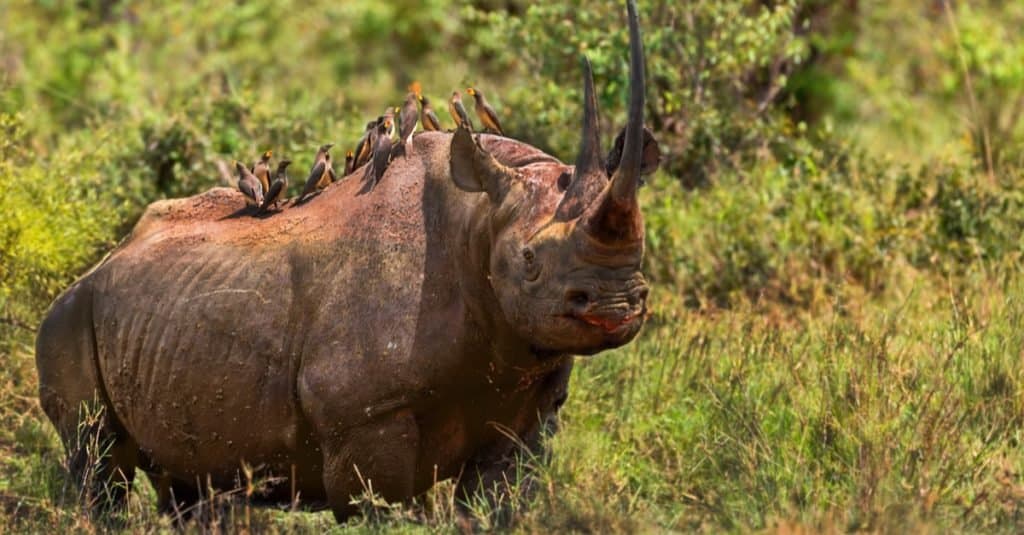
Black rhinos have a pointed lip because they’re browsers.
©Maggy Meyer/Shutterstock.com
The most important difference between a black rhinoceros and a white rhino is their lips. Black rhinos have hooked lips, while white rhinos have square lips.
Black rhinos are smaller than white rhinos. White rhinos can weigh over 5,000 pounds, while black rhinos only hit a max of about 2,200 lbs.
Also, both have horns made of keratin. Keratin is the material that makes up human fingernails and horse hooves. It’s strong yet malleable, which makes it useful in many applications and why poaching is such a problem. It’s not one niche group or one product that is causing the poaching epidemic.
The shapes of their horns are also a clear indicator of the species. White rhinos generally have a larger front horn than black rhinos. While both have a second back horn that’s shorter than the front, the size differentiation of the horns is more proportional on the black rhino.
The biggest difference between black and white rhinoceroses is their lips. White rhinos are grazers that eat mostly grass. Black rhinos, on the other hand, have pointed lips because they feed on branches and their accompanying leaves. They especially love acacias.
Subspecies of the white rhino are going extinct, as with the black rhino. There is one pair of northern white rhinos that are guarded 24 hours a day in Kenya, but there is no way those two rhinos are capable of restoring any kind of viable population. Northern white rhinos are functionally extinct.
What is an Asian Rhino?

Javan rhinoceroses now only exist on the island of Java in Indonesia.
©Maximilian Pawlikowsky/Shutterstock.com
Asian rhinos are rhinoceroses native to Asia. There are three species; the greater one-horned rhino, the Javan rhino, and the Sumatran rhino. They differ from African rhinoceroses in a few ways.
The folds in their skin make them look armored in comparison to Africa’s species. They’re grazers that like leaves, fruit, grass, and shrubs. They’re fans of the water and are often found near it.
Asian rhino habitats include marshlands, grasslands, and forests, which have been decimated by residential structures, logging, and agriculture.
Like all rhinoceroses, poaching and loss of habitat are what is driving some of them to extinction. Javan rhinos no longer exist on the mainland and only inhabit the island of Java, Indonesia. There are less than 100 Sumatran rhinos left in their natural habits.
The Asian one-horned rhino is a conservation success story, though they aren’t completely out of the woods. Most of the population is located in one national park in India.
Anything that may threaten this sanctuary could mean the end for the Asian one-horned rhino. One such event would be a disease that could run rampant through such a tightly grouped population.
How are Rhinoceroses Transported During Reintroductions?
Helicopters are used to transfer rhinoceroses that are being returned to their historical habitats and to conservatories that conduct breeding programs. They are sedated and then secured by their ankles to the bottom of a helicopter. They then fly through the air upside down to their new destination.
This is good for the rhinoceros for a variety of reasons. The trips are shorter, fewer tranquilizers need to be administered before travel, and no attempts need to be made to figure out how to cage 2,000 lb animals during transport.
The photo featured at the top of this post is © EcoPrint/Shutterstock.com
Thank you for reading! Have some feedback for us? Contact the AZ Animals editorial team.



